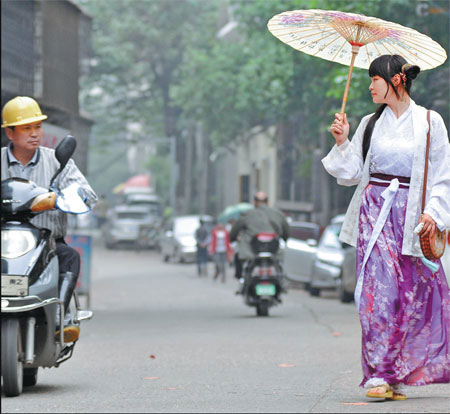
|
About two years ago, Long Jiayan accidentally watched a video about hanfu, or Han clothing, on a micro blog in China. She didn't expect that it would inspire her life's passion to promote Han clothing and its history. Hanfu is the traditional dress of the ethnic Han people. However, few Han people wear it daily in present-day China. It can be seen occasionally in festivals, coming-of-age and religious ceremonies conducted by Taoist, Confucian and Buddhist monks. It is often seen, however, in Chinese television serials and movies. "I absolutely fell in love with hanfu, including all of its connotations and cultural implications after watching the video," says the 24-year-old in Changsha, Hunan province. Long was so crazy about hanfu that she, who never learned sewing before, started to make an outfit only four days after she watched the video. "I searched for information about how to make hanfu and felt after my reading that it was not that difficult, so I just set to work on it," she recalls. Long's baby was just 7 months old, so she could only make the clothes when the baby slept or when it was being cared by its grandmother. But Long's idea didn't get any support from her family. "My mother-in-law said I had a 'mental disorder' and it was unnecessary and boring to do that," she says. Long finished her first hanfu in only three days, even though she didn't have a sewing machine, and she wore it immediately. "Honestly, I don't know how I managed to keep that mental state then. I was fully at ease, though I had expected that people would look at me strangely," Long says. Now Long wears hanfu at least half the time. Sometimes she also chooses to wear some modern items to go with her hanfu. "When I wear hanfu on the street, some people even ask if I'm doing cosplay or wearing a costume rented from a photographic studio," she says. "But I was quite happy to hear that some children called me fairy sister," she says. One month later after she made the first hanfu, she bought a sewing machine for 800 yuan ($129). "I'm the type of person who takes action. I spent all of my pocket money on the sewing machine and the cloth," Long says. Now Long has her workshop and has made several hundred hanfu, but learning how to stitch was not easy. "What I can do is to turn to the pictures about hanfu and search for instructions some people post on the Internet. I bought some cheap cloth and tried to make hanfu with that," she says. Long has so far concentrated on the clothing's cut and form. "I plan to do myself print, dye and embroider on the clothes that I make. But that requires more effort as traditionally pictures are used on hanfu and some pictures cannot be used on some types of fabric," she says. In June last year, Long launched her online store. Many people have come to her workshop, tried her hanfu and taken pictures, but sales are low. Long says she has been in debt of more than 10,000 yuan. Her suits mostly cost 300-400 yuan. "But many people still think they are expensive," Long says. Sometimes, she says, she has to spend more than one month browsing hundreds of webpages and looking into thousands of cloth types to find what she wants. Long isn't alone in her dream to rejuvenate traditional Chinese culture through hanfu. At a festival where most people wore hanfu, she met Chen Jiaxin, who has launched various traditional ceremonies. The two are now cooperating. "Chen's activities need a lot of hanfu. I offer them the costumes they need so that they can make use of them to promote traditional culture," Long says. |
据《中国日报》报道,约两年前,龙佳言偶然在中国的微博上看到关于汉服,或称为汉衣冠的视频。她并未预料到这会激发她的生活热情,去发扬汉服及其历史。 汉服是汉族人民的传统服饰。然而,在当代中国,鲜有汉人会每天穿它。偶尔可在由道教、儒教和佛教僧侣组织的节日、成人礼和宗教活动中看到。 但在中国电视连续剧和电影中,可经常看到。 在看完视频后,我完全爱上了汉服,包括它的一切内涵和文化寓意,”来自湖南长沙的24岁女子称。 龙佳言对汉服非常痴迷,因此,从未学过裁缝的她,在看完视频的四天后就开始制作汉服。 “我搜索了关于如何做汉服的信息,读完后发现并不是那么难,于是我就开始制作汉服了,”她回忆道。 龙佳言的宝宝仅7个月大,因此,她只能在宝宝睡觉或在外婆照看时做衣服。 但是龙佳言的想法未得到家人的任何支持。她说:“我婆婆说我‘精神失常’,没必要做,而且很枯燥,” 虽然没有缝纫机,但是龙佳言仅在三天内就完成了她的第一套汉服,她立刻就穿上了。 龙佳言说:“说实话,我不知道当时是如何设法保持那种精神状态的。我完全放松,尽管我想过人们会用奇怪的眼神看我。” 现在,龙佳言至少一半的时间都穿汉服。有时她也选戴一些现代元素的饰物和她的汉服搭配。 她说:“当我穿着汉服上街时,一些人甚至问我是不是在cosplay,或者穿的是从影城租来的衣服。” “但我很高兴一些小孩叫我神仙姐姐,”她说道。 在她做完第一套汉服的一个月后,她花800元买了一台缝纫机。 龙佳言说:“我是那种行动派的人。我把所有零用钱都花在缝纫机和布料上。” 现在龙佳言有了自己的工作室,她已经做了几百套汉服,但学习缝纫并不容易。 她说:“我能做的就是找关于汉服的图片,在网上搜索一些人发布的说明。我买了一些便宜的布料,尝试用它做汉服。” 龙佳言到目前为止一直集中在服装的剪裁和样式上。她说:“我打算在我做的衣服上自己印花样、染色和刺绣。但那和汉服上用传统图案相比更费精力,一些图案不能用在某些类型的布料上。” 去年6月,龙佳言注册了网上店铺。很多人去她的工作室试穿汉服、拍照,但是销量很低。 龙佳言说她已经欠债超过1万元了。她的一套衣服大多是花费300-400元。“但很多人仍觉得那很贵,”龙佳言说道。 她说,有时候她不得不花一个多月的时间浏览数百个网页,寻找成千上万个布种才能找到自己想要的。 龙佳言在她用汉服复兴传统中国文化的路上并不孤独。在一个大多数人穿汉服的节日里,她遇到了发起过各种传统仪式的陈嘉欣。 这二位现在正在合作。 龙佳言说:“陈嘉欣的活动需要大量的汉服,我为他们提供所需服装,以便他们可以利用服装来促进传统文化。” (译者 panda123 编辑 丹妮) 扫一扫,关注微博微信
  |
